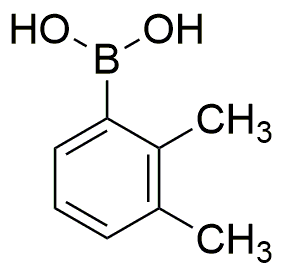2,3-Dimethylphenylboronic acid is widely utilized in research focused on:
- Organic Synthesis: This compound serves as a key building block in the synthesis of various organic molecules, particularly in the development of pharmaceuticals and agrochemicals, enhancing the efficiency of chemical reactions.
- Drug Development: It plays a crucial role in medicinal chemistry, where it is used to create boron-containing compounds that can improve the efficacy of drug candidates, particularly in targeting specific biological pathways.
- Materials Science: The compound is employed in the production of advanced materials, including polymers and nanomaterials, which can exhibit unique properties beneficial for electronics and coatings.
- Bioconjugation: It is utilized in bioconjugation techniques, allowing researchers to attach biomolecules to surfaces or other molecules, which is essential in the development of biosensors and targeted drug delivery systems.
- Environmental Applications: This chemical is also explored in environmental chemistry for the detection and removal of pollutants, contributing to cleaner technologies and sustainable practices.
General Information
Properties
Safety and Regulations
Applications
2,3-Dimethylphenylboronic acid is widely utilized in research focused on:
- Organic Synthesis: This compound serves as a key building block in the synthesis of various organic molecules, particularly in the development of pharmaceuticals and agrochemicals, enhancing the efficiency of chemical reactions.
- Drug Development: It plays a crucial role in medicinal chemistry, where it is used to create boron-containing compounds that can improve the efficacy of drug candidates, particularly in targeting specific biological pathways.
- Materials Science: The compound is employed in the production of advanced materials, including polymers and nanomaterials, which can exhibit unique properties beneficial for electronics and coatings.
- Bioconjugation: It is utilized in bioconjugation techniques, allowing researchers to attach biomolecules to surfaces or other molecules, which is essential in the development of biosensors and targeted drug delivery systems.
- Environmental Applications: This chemical is also explored in environmental chemistry for the detection and removal of pollutants, contributing to cleaner technologies and sustainable practices.
Documents
Safety Data Sheets (SDS)
The SDS provides comprehensive safety information on handling, storage, and disposal of the product.
Product Specification (PS)
The PS provides a comprehensive breakdown of the product’s properties, including chemical composition, physical state, purity, and storage requirements. It also details acceptable quality ranges and the product's intended applications.
Certificates of Analysis (COA)
Search for Certificates of Analysis (COA) by entering the products Lot Number. Lot and Batch Numbers can be found on a product’s label following the words ‘Lot’ or ‘Batch’.
*Catalog Number
*Lot Number
Certificates Of Origin (COO)
This COO confirms the country where the product was manufactured, and also details the materials and components used in it and whether it is derived from natural, synthetic, or other specific sources. This certificate may be required for customs, trade, and regulatory compliance.
*Catalog Number
*Lot Number
Safety Data Sheets (SDS)
The SDS provides comprehensive safety information on handling, storage, and disposal of the product.
DownloadProduct Specification (PS)
The PS provides a comprehensive breakdown of the product’s properties, including chemical composition, physical state, purity, and storage requirements. It also details acceptable quality ranges and the product's intended applications.
DownloadCertificates of Analysis (COA)
Search for Certificates of Analysis (COA) by entering the products Lot Number. Lot and Batch Numbers can be found on a product’s label following the words ‘Lot’ or ‘Batch’.
*Catalog Number
*Lot Number
Certificates Of Origin (COO)
This COO confirms the country where the product was manufactured, and also details the materials and components used in it and whether it is derived from natural, synthetic, or other specific sources. This certificate may be required for customs, trade, and regulatory compliance.


